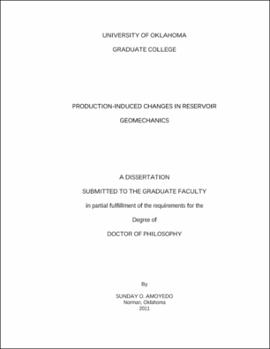| dc.contributor.advisor | Slatt, Roger M.||Marfurt, Kurt J. | |
| dc.creator | Amoyedo, Sunday Oluleye | |
| dc.date.accessioned | 2019-04-27T21:32:11Z | |
| dc.date.available | 2019-04-27T21:32:11Z | |
| dc.date.issued | 2011 | |
| dc.identifier | 99278308002042 | |
| dc.identifier.uri | https://hdl.handle.net/11244/318936 | |
| dc.description.abstract | Sand production remains a source of concern in both conventional and heavy oil production. Porosity increase and changes in local stress magnitude, which often enhance permeability, have been associated with severe sanding. On the other hand, sand production has been linked to a large number of field incidences involving loss of well integrity, casing collapse and corrosion of down-hole systems. It also poses problems for separators and transport facilities. Numerous factors such as reservoir consolidation, well deviation angle through the reservoir, perforation size, grain size, capillary forces associated with water cut, flow rate and most importantly reservoir strain resulting from pore pressure depletion contribute to reservoir sanding. Understanding field-specific sand production patterns in mature fields and poorly consolidated reservoirs is vital in identifying sand-prone wells and guiding remedial activities. Reservoir strain analysis of Forties Field, located in the UK sector of the North Sea, shows that the magnitude of the production-induced strain, part of which is propagated to the base of the reservoir, is of the order of 0.2 %, which is significant enough to impact the geomechanical properties of the reservoir. Sand production analysis in the field shows that in addition to poor reservoir consolidation, a combined effect of repeated perforation, high well deviation, reservoir strain and high fluid flow rate have contributed significantly to reservoir sanding. | |
| dc.description.abstract | Knowledge of reservoir saturation variation is vital for in-fill well drilling, while information on reservoir stress variation provides a useful guide for sand production management, casing design, injector placement and production management. Interpreting time-lapse difference is enhanced by decomposing time-lapse difference into saturation, pressure effects and changes in rock properties (e.g. porosity) especially in highly compacting reservoirs. Analyzing the stress and saturation sensitivity of the reservoir and overburden shale of Forties Field, I observe that while pore pressure variations have not been significant in most parts of the field, a relatively higher decrease in pore pressure in a region of the reservoir has affected the geomechanical properties of both reservoir and overlying rock strata . I found that strain development in the field accounts, in part, for increased reservoir sand production and a negative velocity change in the overburden, which provides an indication of dilation. I use changes in the AVO intercept and gradient calibrated with laboratory measurements to decouple the time-lapse (4D) difference into saturation and pressure changes. Furthermore, I propose a new modification to time-lapse AVO inversion workflows to account for the effect of porosity change in measurements of time-lapse difference. This is particularly crucial in highly-compacting chalk and poorly consolidated clastic reservoirs. | |
| dc.description.abstract | Rock-physics-driven inversion of 3D pre-stack seismic data plays a prominent role in the characterization of both reservoir and overburden rocks. Understanding the rock physics of the overburden rock is required for efficient production of the reservoir and to safeguard wellbore, down-hole assembly and supporting surface facilities. Taking Forties Field as a case study, I observe that while instability and subsequent failure of the overburden in the field can be linked to the rapid decrease of the unconfined compressive strength (UCS) at inclinations close to 45 degrees to the bedding plan, some zones in the overburden are characterized by extreme weakness regardless of the well angle through the rock. I use the correlation between unconfined compressive strength and elastic moduli (Young's and Bulk moduli), coupled with the results of simultaneous inversion to derive 3D elastic moduli, calibrated to laboratory measurements, to characterize the zones of extreme weakness. | |
| dc.description.abstract | Time-lapse gravimetry continues to find increasing application in reservoir monitoring, typically in gas reservoirs and reservoirs used for CO2 sequestration. There is little or no application yet in oil-bearing reservoir monitoring, due in part to the low density contrast between oil and brine and the high acquisition cost associated with the required survey grid closely spaced. In this study, I model the 4D gravity anomaly over Forties Field. Forties Field 4D gravity model results show that a significant increase in water saturation (10-15%) is required to produce a resolvable 4D gravity anomaly. I observe that time-lapse gravity anomalies can provide vital clues to reservoir compartmentalization and by-passed oil when the saturation change is on the order of 10% or more. Reservoir subsidence can also give rise to a significant 4D gravimetric anomaly. I observe a decreasing resolution of such compaction anomalies as water saturation increases. | |
| dc.format.extent | 174 pages | |
| dc.format.medium | application.pdf | |
| dc.language | en_US | |
| dc.relation.requires | Adobe Acrobat Reader | |
| dc.subject | Oil reservoir engineering | |
| dc.subject | Petroleum--Geology | |
| dc.subject | Hydrocarbon reservoirs | |
| dc.subject | Oil sands | |
| dc.title | Production-Induced Changes in Reservoir Geomechanics | |
| dc.type | text | |
| dc.type | document | |
| dc.thesis.degree | Ph.D. | |
| ou.group | Mewbourne College of Earth and Energy::ConocoPhillips School of Geology and Geophysics | |
